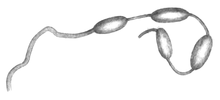Diplosolenodes occidentalis
| Diplosolenodes occidentalis | |
|---|---|
 | |
| Drawing of dorsal and ventral view of Diplosolenodes occidentalis from its original type description. | |
 | |
| Ventral view of a preserved specimen of Diplosolenodes occidentalis | |
| Scientific classification | |
| Kingdom: | Animalia |
| Phylum: | Mollusca |
| Class: | Gastropoda |
| (unranked): | clade Heterobranchia clade Euthyneura |
| Superfamily: | Veronicelloidea |
| Family: | Veronicellidae |
| Genus: | Diplosolenodes |
| Species: | D. occidentalis |
| Binomial name | |
| Diplosolenodes occidentalis (Guilding, 1825)[1] | |
| Synonyms | |
Diplosolenodes occidentalis is a species of air-breathing land slug, a terrestrial pulmonate gastropod mollusk in the family Veronicellidae, the leatherleaf slugs.
Distribution
Diplosolenodes occidentalis was originally discovered and described by Lansdown Guilding from the West Indian island of Saint Vincent. It seems likely that this species is native to most of the Lesser Antilles.[3]
The distribution of Diplosolenodes occidentalis includes the Lesser Antilles:
It has been introduced to the Greater Antilles, Central America and northern South America:[3]
- Nicaragua[5]
- Costa Rica[6]
- In El Hatillo Miranda state - Venezuela[7][8][9][10]
It occurs in greenhouses in Logan County, Oklahoma.[11]
This species has not yet become established in the wild in the USA, but it is considered to represent a potentially serious threat as a pest, an invasive species which could negatively affect agriculture, natural ecosystems, human health or commerce. Therefore, it has been suggested that this species be given top national quarantine significance in the USA.[12]
Description
This slug is most easily recognized by the black speckling on its mantle or hyponota.[3] The body length can reach up to 60 mm.[11]

Ecology
This species may be found in undisturbed environments as well as in agricultural settings, where it may be regarded as a minor pest.[3]
References
This article incorporates CC-BY-3.0 text from the reference.[3]
- ↑ Guilding L. (1825). "Description of a new species of Onchidium". [Read 4 November 1823.] Transactions of the Linnean Society of London 14: 322-324, table IX.
- 1 2 Angas G. F. (1884). "On the terrestrial Mollusca of Dominica, collected during a recent visit to that island". Proceedings of the Zoological Society of London 1883: 594-597, figs. 1-3.
- 1 2 3 4 5 6 7 8 Robinson D. G., Hovestadt A., Fields A. & Breure A. S. H. (July 2009). "The land Mollusca of Dominica (Lesser Antilles), with notes on some enigmatic or rare species". Zoologische Mededelingen 83 http://www.zoologischemededelingen.nl/83/nr03/a13
- 1 2 Pilsbry H. A. (1892). "On a collection of land Mollusca from the Island of Dominica, West Indies". Transactions of the Connecticut Academy of Science 8: 356-358.
- ↑ (in Spanish) Pérez A. M., Sotelo M., Arana I. & López A. (2008). "Diversidad de moluscos gasterópodos terrestres en la región del Pacífico de Nicaragua y sus preferencias de hábitat". Rev. Biol. Trop. 56(1): 317-332,. PDF
- ↑ (in Spanish) Barrientos Z. (2003). "Lista de especies de moluscos terrestres (Archaeogastropoda, Mesogastropoda, Archaeopulmonata, Stylommatophora, Soleolifera) informadas para Costa Rica". Rev. Biol. Trop. 51(Suppl. 3): 293-304. PDF
- ↑ Baker, Horace B. 1927: The mollusca collected by the University of Michigan – Williamson expedition in Venezuela. Occasional Paper of Museum of zoology. 182:1-51
- ↑ Martínez E, Rafael y Miranda A, Rafael E. 1968: Aspectos de la reproducción en moluscos pulmonados del área metropolitana de Caracas. En: Estudio de Caracas. Ecología vegetal - fauna Vol:II pp:123-165. Universidad Central de Venezuela. Caracas-Venezuela
- ↑ Fernández de V, J. 1992: Contribución al conocimiento de las babosas y sietecueros (Mollusca: Gastropoda) Revista de la Facultad de Agronomía Maracay. 12(3-4):374-387.
- ↑ Gomes, Suzete R. 2007: Filogenia morfológica de Veronicellidae, filogeniamolecular de Phyllocalis Colosi e descriçao de uma nova espécie para la família (Mollusca, Gastropoda, Pulmonata). Gomes, Suzete R. 2007. Universidade Federal do Rio Grande do Sul. Porto Alegre. 175p. PDF
- 1 2 Branson B. A. (1980). "The Recent Gastropoda of Oklahoma, Part VIII. The Slug Families Limacidae, Arionidae, Veronicellidae, and Philomycidae". Proceedings of the Oklahoma Academy of Science. 60: 29-35. PDF.
- ↑ Cowie R. H., Dillon R. T., Robinson D. G. & Smith J. W. (2009). "Alien non-marine snails and slugs of priority quarantine importance in the United States: A preliminary risk assessment". American Malacological Bulletin 27: 113-132. PDF.
Further reading
- Baker H. B. (1925). "North American Veronicellidae". Proceedings of the Academy of Natural Sciences of Philadelphia 77: 157-184, Pl. 3-6. JSTOR
- Coto A. T. D. (1983). "Combate de la babosa Diplosolenodes occidentale (Guilding) (Soleolifera: Veronicellidae) con extractos de plantas". Tesis, Universidad de Costa Rica, San Jose. 53 pp.
- Thomé J. W. (1989). "Annotated and illustrated preliminary list of the Veronicellidae (Mollusca[ Gastropoda) of The Antilles, and Central and North America". J. Med. & Appl. Malacol. 1: 11-28.
- Thomé J. W. (1993). "Estado atual da sistemática dos veronicellidae (Mollusca; Gastropoda) americanos, con comentários sobre sua importáncia económica, ambiental e na saúde". Biociéncias, Porto Alegre 1(1): 61-75.
- Thomé J. W., dos Santos P. H. & Pedott L. (1997). "Annotated list of Veronicellidae from the collections of the Academy of Natural Sciences of Philadelphia and the National Museum of Natural History, Smithsonian Institution, Washington D.C., U.S.A. (Mollusca: Gastropoda: Soleolifera)". Proceedings of the Biological Society of Washington 110: 520-536, figs 1-16. page 522.
- Julieta Fernandez de V. (1982). "Contribucion al Conocimiento de las Babosas y Sietecueros (Mollusca: Gastropoda) Que Causan Daños a la Agricultura en Venezuela". Rev. Fac. Agron. (Maracay), XII(3-4). 353-386. http://avepagro.org.ve/fagro/v12_34/v124m010.html - listed as Latipes pterocaulis in Venezuela.
| Wikimedia Commons has media related to Diplosolenodes occidentalis. |